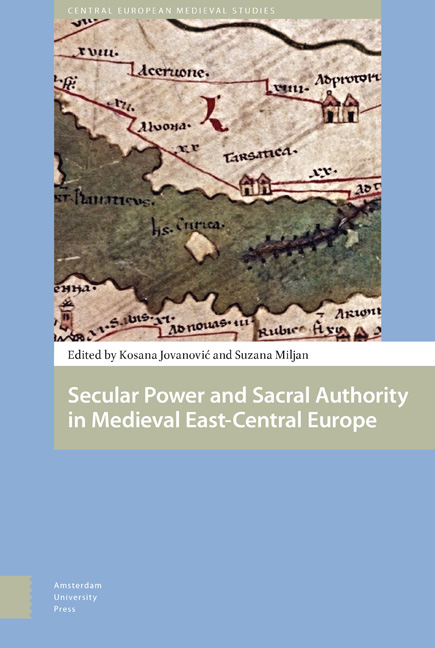Book contents
- Frontmatter
- Contents
- List of Figures and Tables
- Acknowledgements
- Foreword
- Folklore of the Medieval Kings of Hungary: Preliminary Research Report
- Variations on Nobility in Central and South-Eastern Europe: An Introduction
- The Changes of Office of Ban of Slavonia after the Mongol Invasion in Hungary (1242-1267)
- The Reconstruction and Role of Roads in the Formation of a Medieval Cultural Landscape: The Example of Episcopal Estates of Dubrava, Ivanić and Čazma
- From Castle-Warrior to Nobleman: Case Study of a Family of Slavonian Lesser Nobility
- Late Medieval Village in Turopolje (Slavonia): The Example of Donja Lomnica
- Economic Development and Transformation of the Pauline Monasteries near Senj under the Frankapan Patronage
- The Society of the Noble Judges in Northeastern Hungary during the Reign of King Sigismund (1387-1437)
- Development of Ragusan Diplomatic Service in the First Half of the Fifteenth Century: Father and Son at the Court of Duke Sandalj Hranić
- Croatian Students at the University of Prague in the Fifteenth Century
- A Contribution to Medieval Croatian Diplomatics: Cyrillic Charters of Croatian Nobility from the Franciscan Monastery on Trsat in Rijeka
- Peter of Crkvica, a Man Who Could Be Trusted: The Career of a Middle-Ranking Cleric and Diplomat in the Kingdom of Hungary in Mid-Fifteenth Century
- The Nobility of the Despotate of Serbia between Ottoman Empire and Hungary (1457-1459)
- List of Contributors
- Index
The Society of the Noble Judges in Northeastern Hungary during the Reign of King Sigismund (1387-1437)
Published online by Cambridge University Press: 12 December 2020
- Frontmatter
- Contents
- List of Figures and Tables
- Acknowledgements
- Foreword
- Folklore of the Medieval Kings of Hungary: Preliminary Research Report
- Variations on Nobility in Central and South-Eastern Europe: An Introduction
- The Changes of Office of Ban of Slavonia after the Mongol Invasion in Hungary (1242-1267)
- The Reconstruction and Role of Roads in the Formation of a Medieval Cultural Landscape: The Example of Episcopal Estates of Dubrava, Ivanić and Čazma
- From Castle-Warrior to Nobleman: Case Study of a Family of Slavonian Lesser Nobility
- Late Medieval Village in Turopolje (Slavonia): The Example of Donja Lomnica
- Economic Development and Transformation of the Pauline Monasteries near Senj under the Frankapan Patronage
- The Society of the Noble Judges in Northeastern Hungary during the Reign of King Sigismund (1387-1437)
- Development of Ragusan Diplomatic Service in the First Half of the Fifteenth Century: Father and Son at the Court of Duke Sandalj Hranić
- Croatian Students at the University of Prague in the Fifteenth Century
- A Contribution to Medieval Croatian Diplomatics: Cyrillic Charters of Croatian Nobility from the Franciscan Monastery on Trsat in Rijeka
- Peter of Crkvica, a Man Who Could Be Trusted: The Career of a Middle-Ranking Cleric and Diplomat in the Kingdom of Hungary in Mid-Fifteenth Century
- The Nobility of the Despotate of Serbia between Ottoman Empire and Hungary (1457-1459)
- List of Contributors
- Index
Summary
In this article, I will examine a special social group within the lesser nobility in the Kingdom of Hungary. The history of the European lesser nobility, especially in the Western Europe, is a well-researched field and has a great historiography. For instance, it is a known fact that the English gentry was a much more open class than the French nobility. However, Edouard Perroy – after the reconstruction of the noble society of Forez County – observed that neither was the French lesser nobility closed; there were opportunities for the newcomers to establish a new noble linage. Philippe Contamine has several works about the French noble society and examined the differences between the English ‘gentleman’ and the French ‘gentilhomme’. In the UK, the followers of K.B. McFarlane published several books about the local nobility of the English shires. In Germany, Joachim Scheider wrote a comprehensive monograph wherein he compared the ‘niederadel’ of Bayern, Saxony, Brandenburg and Austria and made important remarks. Furthermore, I have to mention a volume of studies of the West European gentry and lesser nobility edited by Michael Jones wherein the most important researchers of the field interpreted and compared the lesser nobles of England, Scotland, France, Castile, the Netherlands and the Holy Roman Empire. These essays show the great diversity of the characteristics of the lesser noble society which depend on the country or region.
It is generally agreed that the nobles were more numerous in the kingdoms of East Central Europe (especially in Hungary-Croatia and Poland), than in Western Europe. In the Kingdom of Hungary-Croatia about 3% of the population belonged to the nobles, most of them were poor petty nobles with only a few tenant-peasant plots. The problem can be perceived at a different level as well. Some nobles were present at the royal court and had special privileges, while a much greater part of nobility was formed by groups of local nobles who managed their own estates, served a wealthier noble or baron, and took part in the county administration. The most characteristic members of the latter group were the noble judges (Lat. iudices nobilium, Hung. szolgabírók) and their families.
- Type
- Chapter
- Information
- Publisher: Amsterdam University PressPrint publication year: 2018

